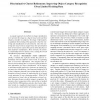Free Online Productivity Tools
i2Speak
i2Symbol
i2OCR
iTex2Img
iWeb2Print
iWeb2Shot
i2Type
iPdf2Split
iPdf2Merge
i2Bopomofo
i2Arabic
i2Style
i2Image
i2PDF
iLatex2Rtf
Sci2ools
CVPR
2007
IEEE
2007
IEEE
Discriminative Cluster Refinement: Improving Object Category Recognition Given Limited Training Data
A popular approach to problems in image classification is to represent the image as a bag of visual words and then employ a classifier to categorize the image. Unfortunately, a significant shortcoming of this approach is that the clustering and classification are disconnected. Since the clustering into visual words is unsupervised, the representation does not necessarily capture the aspects of the data that are most useful for classification. More seriously, the semantic relationship between clusters is lost, causing the overall classification performance to suffer. We introduce "discriminative cluster refinement" (DCR), a method that explicitly models the pairwise relationships between different visual words by exploiting their co-occurrence information. The assigned class labels are used to identify the co-occurrence patterns that are most informative for object classification. DCR employs a maximum-margin approach to generate an optimal kernel matrix for classification. O...
Computer Vision | CVPR 2007 | Discriminative Cluster Refinement | Image Classification | Object Classification | Overall Classification Performance | Visual Words |
| Added | 12 Oct 2009 |
| Updated | 12 Oct 2009 |
| Type | Conference |
| Year | 2007 |
| Where | CVPR |
| Authors | Liu Yang, Rong Jin, Caroline Pantofaru, Rahul Sukthankar |
Comments (0)

